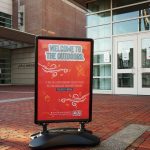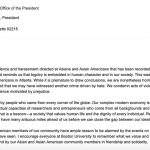
On the heels of Boston University’s first week of classes, students and faculty expressed mixed feelings on their experiences with the hybrid model the University has undertaken for Fall.
With students marking their return — or introduction — to the BU community both on campus and remotely, last week served as the trial run of a new system for professors and students.
Lawford Anderson, a professor in the Earth and Environment Department, said he encountered various technological challenges during week one. The in-person portion of his class went smoothly, he said, but his Zoom class was a “disaster.”
During the lecture, Anderson did not correctly screen-share the presentation slides he was showing his in-person students. He said he was also unable to see the messages sent by his remote students trying to alert him of the issue.
“When I got out of class, I had like 50-odd emails,” Anderson said.
Other remote students, Anderson said, were having issues logging into class due to a password function on Zoom, which he said he was unaware of and had not intentionally set. His next lecture faced the issue of students being unable to hear the lecture over Zoom.
“Initially, I had sound. It went away,” Anderson said. “I couldn’t hear them. They couldn’t hear me, the people in the Zoom. The people in the classroom would hear me just fine because I’m very loud.”
Anderson said he was denied classroom moderators because he had two undergraduate teaching fellows. However, his assistants chose not to attend due to health concerns. Anderson said he at first felt he could manage the new hybrid model on his own, but that after this week, he realized he could not.
“I think the problem for me is that there’s been so much communication about where to learn to do stuff that it’s hard to assimilate all of it,” Anderson said.
Anderson had reached out to Information Services and Technology a week prior to his lectures, and again after his struggles this past week. He has since received two responses from the department and said he is committed to making the most out of the current semester regardless of the circumstances.
“I will make this the best experience they’ve ever had in a classroom no matter whether or not they’re remote or actually there,” Anderson said, referring to his students. “That’s always been my challenge and my wish and my aspiration. I will get there.”
For Patrick Chatelain, a senior in the College of Communication, the first week of in-person classes also started with some technological issues. Both of his lectures were taught by the same instructor, who encountered struggles with the hybrid model.
“The teacher was doing his best,” Chatelain said, “but he really couldn’t quite grasp the Zoom yet.”
His professor had issues syncing up the classroom audio with Zoom audio, Chatelain said, and struggled to display content over the online platform. Classrooms are set up with microphones and cameras to help establish the hybrid environment, but Chatelain said his professor was not aware of the new features.
“He’s a really good professor. He’s just a little bit overwhelmed by the technology and the new setup,” Chatelain said. “I find it really weird. It’s almost as if they didn’t walk the teachers through the setup.”
Janusz Konrad, a professor in the College of Engineering, is teaching one remote lecture with 80 students this semester. He said some of the more challenging aspects of teaching a large, virtual lecture involve engaging students who have their cameras turned off and finding the right pace to teach at.
“I spent two months preparing this class and the logistics were problematic,” Konrad said. “I think I resolved them, although I cannot say it’s going to be very smooth.”
Konrad has graduate teaching fellows monitoring the Zoom chat box to read student questions, but he said he allowed students to interrupt and ask questions directly during the first session of his Signals and Systems course. However, this meant Konrad did not get through everything he had planned.
“I think I will need to adjust the pace of the class,” Konrad said. “And that may require me to slow it down a little bit, so that students have [an] opportunity to interact.”
Despite his lecture being fully remote, Konrad said he wanted to include an in-person component to his class in the form of labs. Due to the nature of the course, labs can be done remotely, but students have the option to attend them in person in a computer lab with undergraduate teaching fellows available to help.
Konrad said he was mostly content with how his first lecture of the semester turned out.
“I wasn’t 100 percent happy with the first class, but I was 90 percent happy,” Konrad said, “which is, I think, a good achievement for Zoom.”
Senior Spanish lecturer Molly Monet-Viera said that by the start of classes, professors were already exhausted from months of preparation, planning and communications with the University over the summer.
As a steward for BU’s Service Employees International Union, Local 509, Monet-Viera and other union members have urged the University to consider faculty opinions in its policymaking process. She said their efforts have not effected much change.
“Professors are scared, they’re tired, they’re confused,” Monet-Viera said. “But we’re also excited. I’m super excited to see everybody. We all are missing human connection.”
Prior to the COVID-19 pandemic, Monet-Viera said she had a lot of experience with Zoom and remote instruction, having taught a “massive” online summer course for the past five years.
“If you’re enthusiastic and you show enthusiasm to your students,” Monet-Viera said, “I think they respond in kind.”
For her Spanish for Heritage and Native Speakers course, Monet-Viera said the majority of her students selected not to go in-person. While she said she was willing to teach the course in the hybrid model, half of her students are studying remotely this semester, and only two students within the other half wanted to attend in-person.
“There’d be two people there and 16 people on Zoom,” Monet-Viera said. “I think a class runs much better if you’ve got it in one modality: all remote or all in-person.”
Celeste Olas, a freshman in Sargent College of Health Rehabilitation Sciences, said her first week in the classroom wasn’t what she had expected. While she was pleased with the measures taken for in-person instruction, she said her lecture felt somewhat isolated.
“I’m definitely very happy that I’m able to see the professor and have that in-person experience,” Olas said. “But it’s definitely lacking that interactive aspect that I was hoping to have just because you can’t really communicate with people around you since they’re so far apart.”
Olas added that getting acquainted with the many applications and platforms professors introduced this past week for their classes has been “overwhelming.”
“I feel like in person, it would be a lot easier for a professor to tell you what the course is going to look like,” Olas said, “whereas doing it through Zoom and all these different platforms, it sometimes leaves a lot of guesswork for the student.”
As a transfer student, College of Arts and Sciences junior Shahaf Dan experienced life as a BU student for the first time this past week. For one of his in-person classes, Dan said he was one of two students in attendance.
Dan, being the first student to walk into class, spent the first few minutes alone with his instructor before another student joined them. The rest of the 22-person class attended via Zoom.
“I assume it might change later, that more people are going to show up if they get confidence in the LfA system,” Dan said, “but for now it was quite disappointing.”
Dan, who transferred from a community college in California which offered exclusively remote learning throughout the spring, said he is happy with the LfA model regardless and is excited to join the BU community.
“Besides classes, I know there’s a lot to do here at the school,” Dan said. “I hope that with safety and caution, and obviously regulations and everything, we’re going to be strong as a community and manage to overcome this challenging semester.”




